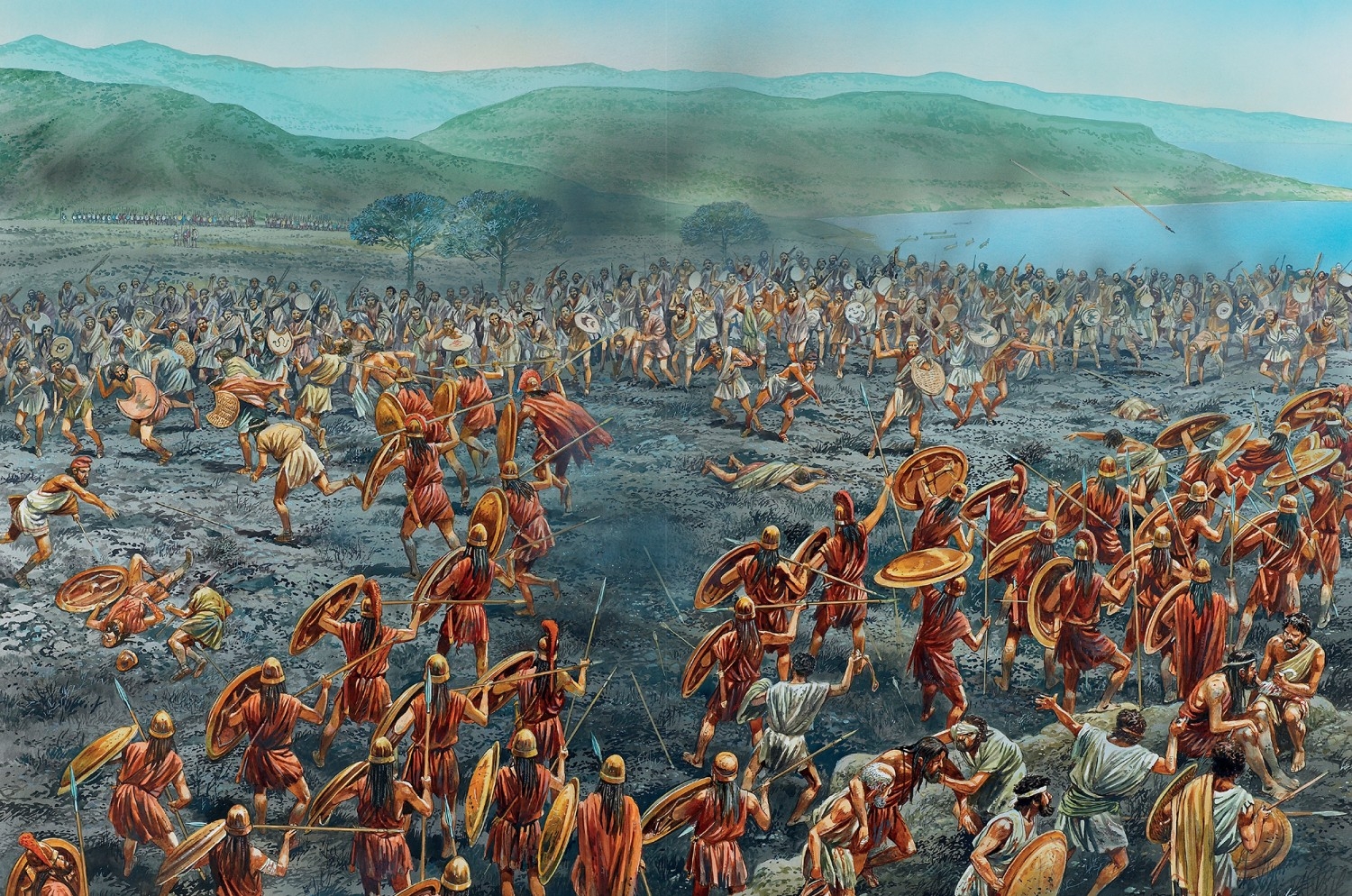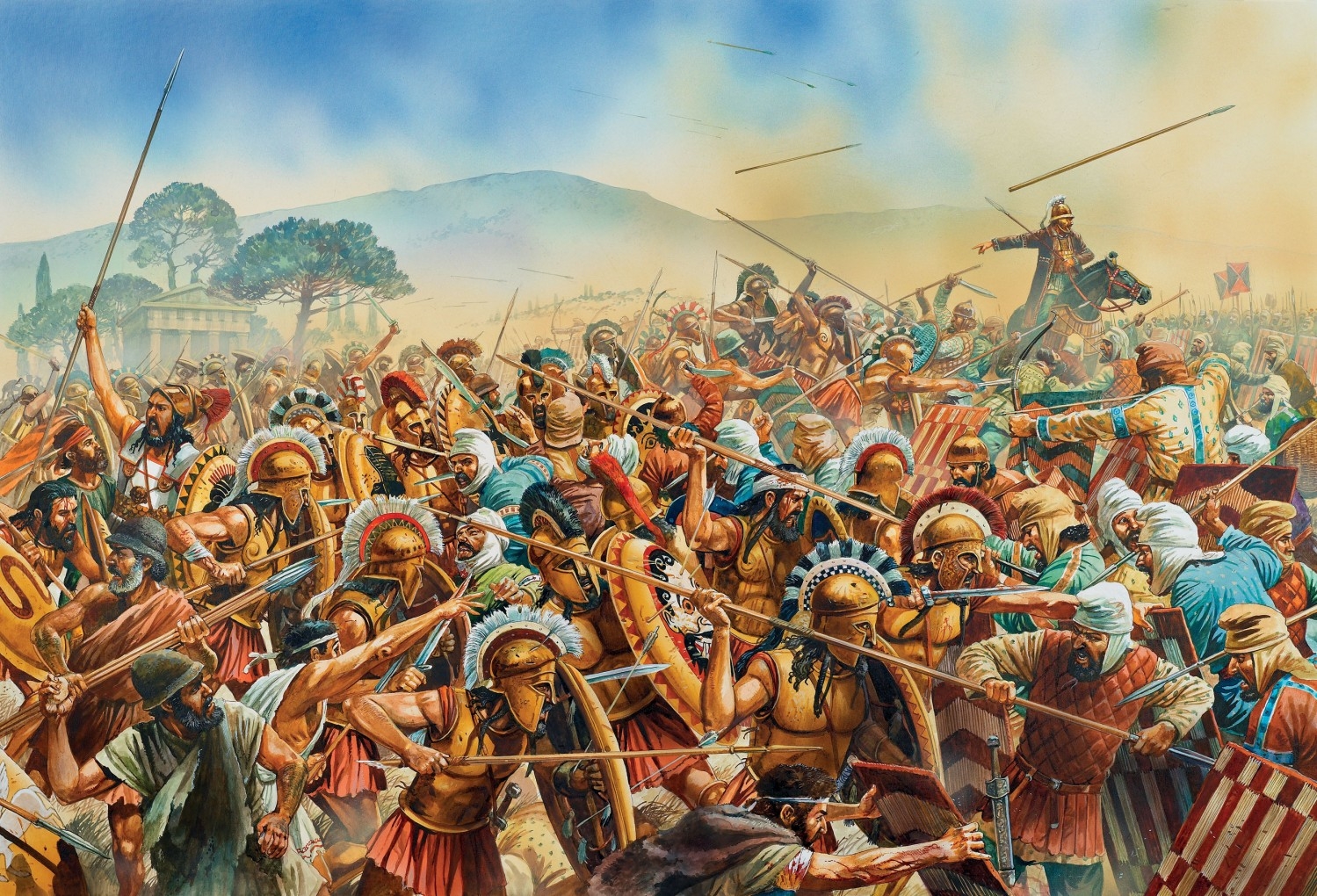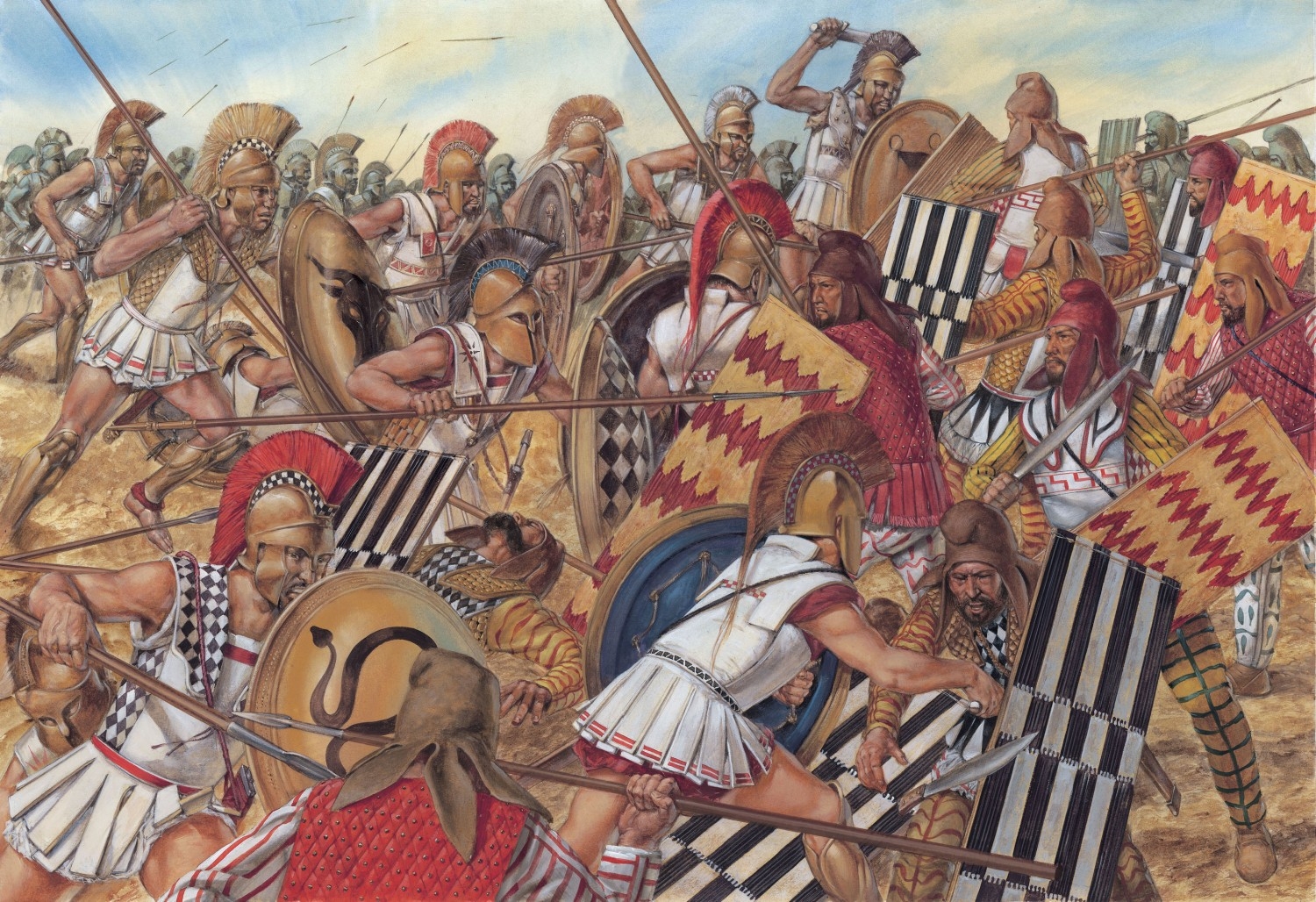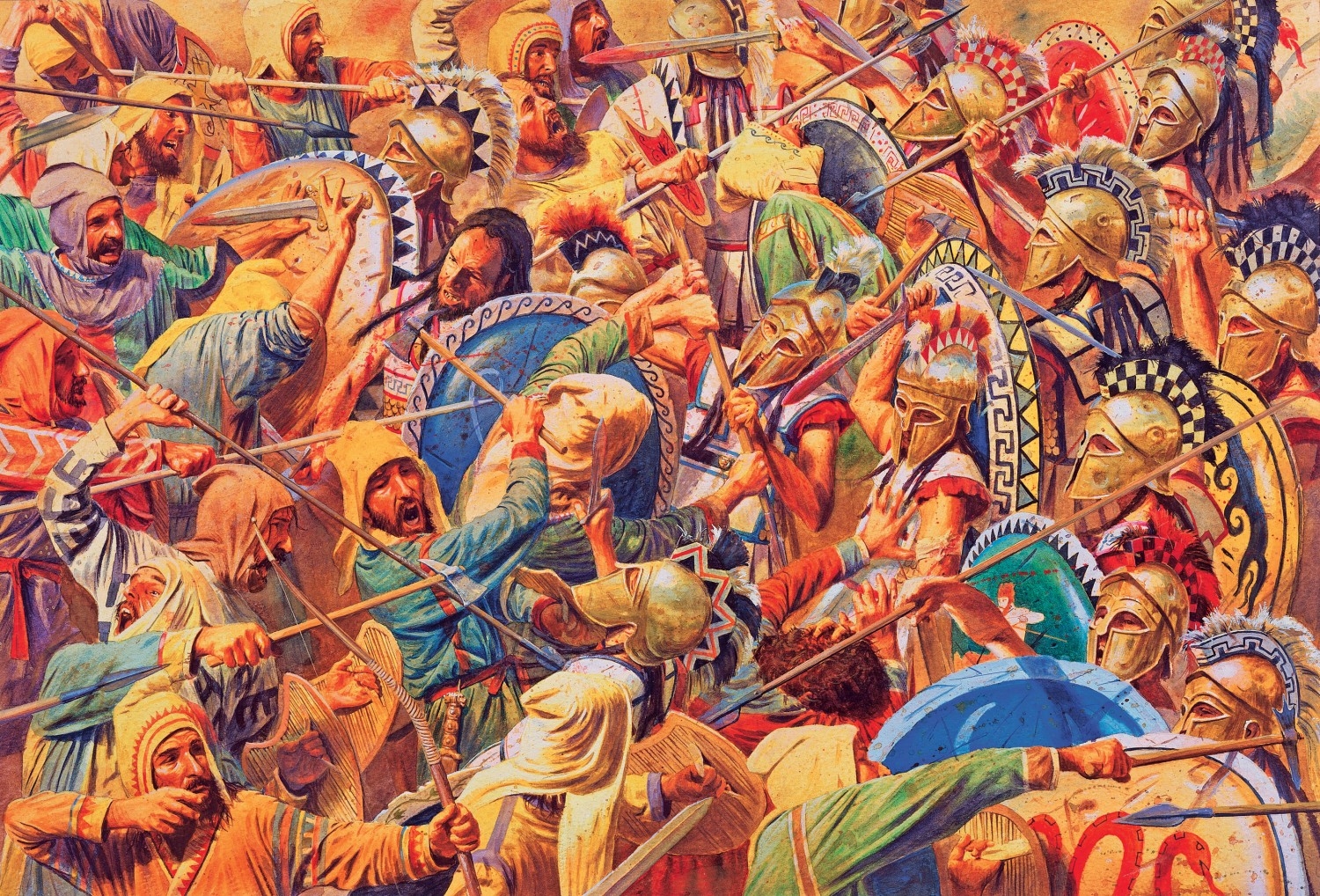Publishing on 18 April, Men of Bronze: Ancient Greek Hoplite Battles allows you to play out Classical Greek hoplite battles on the tabletop. Players are Strategoi (generals) leading phalanxes of bronze-clad warriors in pursuit of fame, glory, and the honor of their city-states. To win such prizes you must prove your mettle, display your valor, and bring the other Strategoi to their knees.
On the blog today we're taking a look back at some famous battles from history to inspire you as you prepare to lead your forces to victory!
Campaign 261: Pylos and Sphacteria 425 BC by William Shepherd
Artwork by Peter Dennis
The Battle on the Island: Psiloi against Hoplites
The extract below is taken from Campaign 261: Pylos and Sphacteria 425 BC by William Shepherd.
‘When the main contingent under Epitadas’ command on the island had seen that their guard post had been wiped out and that the landing force was moving towards them, they formed up and advanced towards the Athenian hoplites with the objective of engaging them in close combat. The hoplites were directly to their front while the psiloi were on their flanks and behind them. But they were unable to get to grips with the hoplites and bring their expertise to bear. The psiloi kept them in check by showering them with missiles from all sides and the Athenian hoplites stayed away from the fight, making no move to meet their advance. Whenever the psiloi came in close the Spartans drove them off, but then they would wheel and renew their attack. They were equipped for mobility and the Spartans with their heavy shields just could not catch up with them on this difficult terrain, which had never been cultivated. So, for a while, the two sides skirmished in this way but the Spartans were becoming tired and less able to dart out in response to each thrust against them.’ (Thucydides IV.33)
The Spartans, Spartiates in this section of the line, are in open order to offer a more difficult target for missile attack. Small groups, generally of the youngest and fittest hoplites in the role of ekdromoi (runners-out), dash forward like snatch-squads in modern riot-policing. Helot attendants provide support of various kinds, including fighting as psiloi. The Athenian peltasts, here mingled with the mass of the psiloi, would have had a limited supply of javelins and would only contemplate hand-to-hand contact with Greece’s finest hoplites if the prolonged skirmishing succeeded in breaking up their formation. The primary weapon for the psiloi was the rocks and stones at their feet. These had to be large enough and thrown at a range of no more than a few metres to be effective, giving the Spartan ekdromoi some opportunity to fight back.
Thucydides’ remark about ground ‘which had never been cultivated’ is a reference to the ideal conditions for hoplite combat as satirised by Mardonius when making the case for the Persian invasion of Greece. Successive Spartan invasions of Attica had failed to provoke the Athenians into overriding one of the key principles of Pericles’ war strategy and Demosthenes was not going to offer this kind of battle on Sphacteria. Some of the triremes that delivered the Athenian forces to the island at daybreak are standing off the accessible western shoreline.
Order your copy of Campaign 261: Pylos and Sphacteria 425 BC to read more about this battle!
Campaign 239: Platea 479 BC by William Shepherd
Artwork by Peter Dennis
‘The most glorious victory ever known’
The extract below is taken from Campaign 239: Platea 479 BC by William Shepherd.
With the omens at last favourable, and the 1,500 Tegeans to their left already committed, the 10,000 Lacedaemonian hoplites and their light-armed support could at last go onto the offensive. The Persians put away their bows and faced up to them. At first the fighting was along the wall of shields but, when this had been knocked over, there was a hard struggle around the temple of Demeter. It went on for such a long time that, for the Greeks, it came down to othismos [shoving with shields with the front lines locked together] because the barbarians kept grabbing their spears and breaking them. The Persians were not inferior in courage or strength, but they were not armed like hoplites or trained in their way of fighting, and they did not have the tactical skill of their opponents. They were darting forward in ones and tens, gathering together in larger or smaller groups, hurling themselves at the Spartans and being wiped out. But wherever Mardonius was fighting, mounted on his charger and surrounded by his thousand picked men, the best of the Persians, there they pressed the enemy hardest. While Mardonius lived, the Persians held out and struck down many Lacedaemonians as they defended themselves. But when Mardonius was killed and the best of the army who fought alongside him had fallen, then the rest were put to flight and gave way before the Lacedaemonians. Their greatest disadvantage was the lack of armour in their equipment. They were, in effect, light-armed (gymnetes, literally ‘naked’) battling with hoplites IX.61–63 Herodotus notes with admiration that the barbarians put up a strong and courageous resistance, in spite of the disadvantages which he so clearly highlights. Othismos was an exclusive element of hoplite warfare marking the climax of conventional hoplite battles and the Greek need to adopt this tactic finally to break the Persians is testimony to their toughness as opponents, outgunned as they were. Herodotus’ respect for Mardonius is equally clear, leading from the front as all the best ancient commanders did and dying his hero’s death. Plutarch adds the detail that a Spartan called Arimnestos killed him with a rock, not a classic hoplite weapon. However, spears and swords broke in combat and then improvisation was an urgent necessity, as in the last stand at Thermopylae. Pausanias, his linothorax contrasting with his men’s bronze cuirasses, has taken his place in the line as customary for Greek generals. There is apparently no evidence for the Spartans adopting the new form of body armour before it was abandoned altogether, but it would have been consistent with the character revealed by some of his behaviour after Plataea for Pausanias to arm himself more flamboyantly. Light-armed Helots are intermingled with the hoplites, one throwing a rock, another bringing up replacement spears. A hoplite fights in the meantime with the butt end of his broken weapon as the Greeks press against the remnants of the barbarian shield wall.
To read more about this battle, take a look at Campaign 239: Plataea 479 BC.
Campaign 195: Syracuse 415 – 413 BC by Nic FIelds
Artwork by Peter Dennis
Night attack on Epipolai

The extract below is taken from Campaign 195: Syracuse 415–413 BC by Nic Fields.
Demosthenes saw that the third Syracusan counter-wall was the key to the whole situation. He therefore planned to seize and destroy it, take control of Epipolai, and then push on with the siege. Demosthenes ordered his men to take five days’ rations, and assembled all the stonemasons, carpenters and archers, and everything else they might require, to complete their circumvallation. Then, at what Thucydides calls ‘the first sleep’ (7.43.2), he himself, with Eurymedon and the bulk of the army, set off, leaving Nikias in the lines. Epipolai is over 100m up, exposed limestone with scrub oak, sheer on its three sides except at its apex near Euryelos in the west, where it is steep but climbable. The barren plateau topside measures some 4.5km west to east and just fewer than 3km at the waist. It was going to be a long and difficult haul. That afternoon the soldiers made the necessary preparations for the forthcoming operation, including the eating of a hot meal. Having roasted and milled their barley, the Athenian hoplites would have taken their flour and kneaded it up with a little oil and wine, using a square of sheepskin as a kneading-trough, to produce a simple form of unleavened bread (Thucydides 3.49.3, Hermippos fr. 57 Kock). The fresh dough would then be twisted around a stick and baked in the hot ashes of their camp fires. Despite Xenophon’s claim (Kyropaideia 1.2.11) that when he was truly famished even barley-bread tasted sweet, it was usually helped down with a little local wine and a wedge of cheese, with onions, garlic, olives, anchovies and thyme-flavoured salt as likely accompaniments (Thucydides 4.26.5, Aristophanes Acharnians 550-551, 1099, Knights 599, Peace 368). That night, having ascended by the hill of Euryelus unobserved by the Syracusan guards, the Athenians captured the fort there from the enemy, putting them to flight. Those fleeing managed to raise the alarm in the three camps on the heights , which were manned by Syracusans and their allies, including the Corinthians. These advanced against the Athenians, but were routed by them after a sharp resistance. Meanwhile other Athenians had taken the third counter-wall of the Syracusans. The Syracusans and their allies, together with Gylippos and the troops under his command, advanced to halt the Athenians from their outworks. The Athenians had begun to lose order in their advance, and came up against the Boiotians, whose brave stand put the Athenians to flight. Although there was a bright moon the fighting degenerated into utter confusion, with one man unable to tell friend from foe in the uncertainties of a night engagement. ‘Thus,’ as Thucydides says, ‘after being once thrown into disorder, they ended by coming into collision with each other in many parts of the field, friends with friends, and citizens with citizens, and not only terrified one another, but even came to blows and could only be parted with difficulty’ (7.44.7).
To read more, pick up a copy of Campaign 195: Syracuse 415–413 BC.
Campaign 108: Marathon 490 BC by Nicholas Sekunda
Artwork by Richard Hook
The Athenian Charge Reaches the Persian Line
The extract below comes from Campaign 108: Marathon 490 BC by Nicholas Sekunda
The Persian infantry regiments were organised in a decimal system, and would have been drawn up ten ranks deep. The file of ten men (dathabam) was commanded by a decurion (dathpati?) who would stand in the front of the file armed with a spear and a pavise (spara). These troops, sparabara, drew their shields together into a shield-wall, from behind which the other nine ranks of archers in the file would shoot. All the Persians shown here are sparabarai, and all are based on the three figures of Persians show on the Oxford Brygos cup. There is a considerable amount of evidence for regimental uniform in the Achaemenid army. Consequently we have taken the opportunity to show three repeated sets of dress and equipment. In fact if the different Persian regiments were dressed uniformly one would not find the members of three different regiments mixed up like this. The majority of figures carry a spara based on that shown on the Oxford Brygos cup although others carry a spara of different construction based on examples recovered by archaeological excavation. The majority of the Persians wear composite cuirasses of a type quite close to the Greek equivalent with which we are familiar. In fact it seems probable that the Greek composite cuirass was inspired by oriental prototypes. Other Persians wear a different type of cuirass reminiscent of the mediaeval ‘jack’ in appearance, and presumably of a similar construction. Some of the sparabara have lost their spears and fight with swords of the kopis type. In contrast the Athenians are of a much more varied appearance. Unlike the mercenaries fighting on the Achaemenid side, each Athenian citizen was responsible for supplying his own equipment. Thus we find the hoplites wearing helmets of Corinthian, Attic, and even Illyrian types. Similarly there is no uniformity among the devices they bear on their shields. By and large the composite cuirass had replaced the muscle cuirass by the time of Marathon. It is possible that the Athenians left their cuirasses and greaves behind in camp once the decision had been made to charge the Persian line at the run. However there is no positive evidence to support this supposition, and indeed late Archaic vases show hoplites charging at the run in full armour. It was common practice at this period to wear ‘garters’ underneath the bottom edge of the greave to prevent chaffing of the skin. These would have been even more necessary at Marathon than was normally the case if the Athenian hoplites ran several hundred metres in greaves.
Pick up a copy of Campaign 108: Marathon 490 BC to read more about the battle.
Campaign 188: Thermopylae 480 BC by Nic Fields
Artwork by Steve Noon
The fall of Leonidas
The extract comes from Campaign 188: Thermopylae 480 BC by Nic Fields.
On the famous last day at Thermopylae the remaining Greeks did not wait passively for the assault. Instead, according to Herodotos (7.223.2), they moved out farther into the broader part of the pass than they had previously done. The fighting was furious, for when most of their ash-wood spears, the main weapon of the hoplite, were broken they began to use their swords. Worse still, it was then that Leonidas fell, and this would not only have left the Greeks temporarily leaderless, but probably have made the surviving Spartans refuse even to contemplate retreat until they had recovered their king’s body. Herodotos says there was ‘much shoving’ (7.225.1), until the Greeks recovered it, flinging the enemy back four times. The fall of the king was the catalyst for an even more ferocious display of valour on the part of the Spartans, conspicuous in their crimson tunics. Among the many Persians who fell fighting over such a valuable trophy were two half-brothers of Xerxes. The Spartans, blinded by the dust kicked up by thousands of feet on all sides, fought furiously in what seemed a sea of Persians, who fought with sagaris, akinakes, spear and bow. For an exhausting hour or so, the throat-parched troops continued to claw away at each other. The lawgiver Lykourgos, it is said by Xenophon, had ordered the Spartans to wear crimson cloaks and tunics, since these garments were ‘least effeminate and most warlike’, and to carry bronze-faced shields, since bronze was ‘quickest to polish and slow to tarnish’ (Lakedaimonion politeia 11.3). The Spartan military cloak, known as a tribo¯n or ‘worn cloak’, is often described as being ‘mean’ (phaulos), that is, thin as opposed to short. Indeed, austerity was the keynote to the Spartan lifestyle, and a Spartiate would visually emphasize his toughness by making use of a single cloak, summer and winter, allowed to wear thin and never washed. This particular article of his uniform was treasured above all else, so much so, if we are to believe Plutarch (Lykourgos 27.1), he would be buried without grave goods, but wrapped in his crimson cloak and crowned with an olive wreath. Of course, for purely practical reasons, the cloak was discarded before battle commenced and left behind in camp. Even so, as Plutarch (Moralia 238f) observes, the crimson-coloured tunic alone would have aroused terror in the inexperienced opponent and helped to disguise battle wounds. The tunic (chitÿn) itself could be a relatively thick woollen garment, though at this time it was generally becoming lighter and sometimes linen replaced wool. It was usually sleeveless, and extended from shoulder to mid thigh. While uniform, in the sense of a national military costume principally fashioned from cloth and codified according to regulations, is a comparatively modern concept, for Sparta, with its intimate relationship between social organization and military power, the adoption of distinctive dress went beyond the mere idea of looking different from one’s foes. For the strength of Sparta’s army lay not only in its professionalism but also in its formidable appearance; this was intentionally designed to strike terror into the hearts of Sparta’s enemies.
Read more about the history of this battle in Campaign 188: Thermopylae 480 BC.
Have these extracts inspired you to lead your forces into battle with Men of Bronze: Ancient Greek Hoplite Battles? Order your copy today!






Comments
You must be logged in to comment on this post. Click here to log in.
Submit your comment